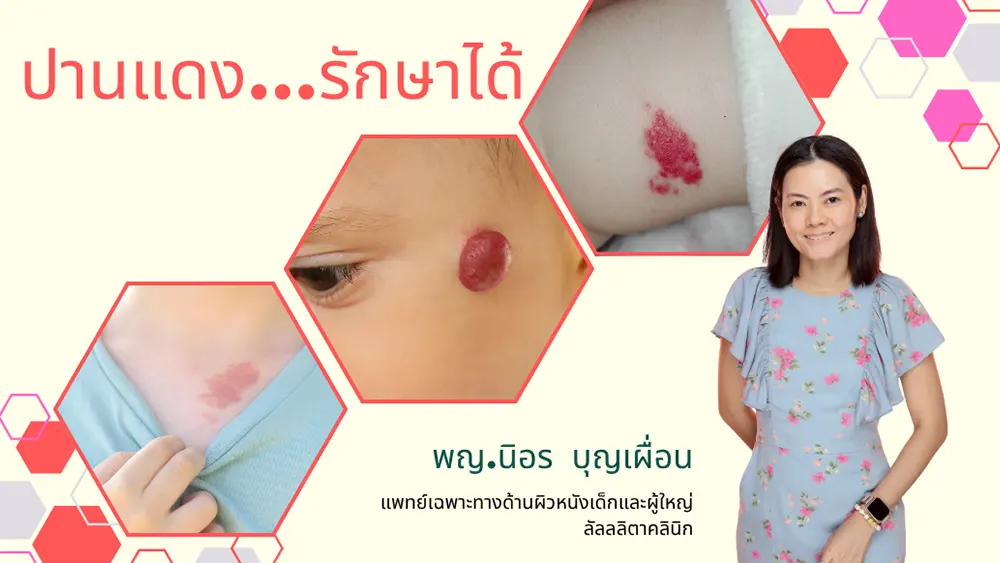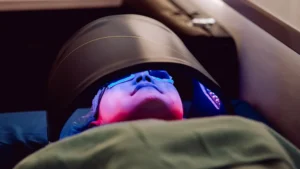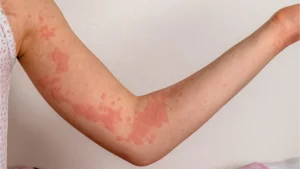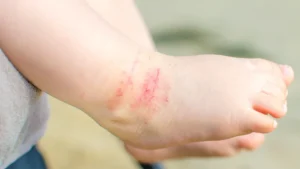Red Birthmarks Are Treatable. Don't Hesitate to See a Doctor.
Red Birthmarks (Vascular Birthmarks)They can appear anywhere on the body, potentially affecting one's appearance and causing significant concern, especially if the birthmark is on the face or is large. Today, effective treatments are available to help patients.
Dr. Niorn Boonpuean Our pediatric and adult dermatologist at Lallalita Clinic has provided the following information about red birthmarks: There are two common types of red birthmarks. The first type is: Infantile HemangiomaInfantile Hemangioma) Typically first noticed around 2-3 weeks of age, appearing as a flat red mark or a small red dot. The tumor then grows rapidly, with a peak growth phase between 6 and 9 months of age. It can be subdivided by depth:
Superficial Infantile Hemangioma Appears as a bright red mark on the skin.
Deep Infantile Hemangioma Appears as a greenish, bluish, or skin-colored lump that can be felt beneath the skin.
In some cases, it can be a mixed type, located in both superficial and deep layers.
The natural course of this condition involves growth until about 1-2 years of age, after which it enters a stable phase of variable duration. Following this, the tumor begins to involute (shrink), its color fading from red to a grayish-purple. It starts to flatten and soften as it is replaced by fatty and fibrous tissue, a process that takes several years.
In most cases, treatment is not necessary, and only monitoring is required, as they typically resolve on their own. However, about 10% of cases require treatment, such as: 1. Hemangiomas on the face that may cause disfigurement or have a risk of scarring. 2. Those in locations that could obstruct vision, such as on an eyelid. 3.Other indications for treatment include rapidly growing tumors that lead to ulceration (breaking of the skin) and bleeding.
If a hemangioma is located on one side of the forehead and is larger than 5 cm, you should consult a doctor immediately for a thorough examination and further testing. This is due to the risk of PHACEs syndrome, which can involve abnormalities of the brain, heart, major arteries, and eyes, and requires a multidisciplinary team of specialists for management.
Furthermore, if there are 5 or more hemangiomas, further investigation is needed due to the risk of internal hemangiomas in organs like the liver or gastrointestinal tract, which can lead to blood loss or death, as well as thyroid dysfunction.
There are several treatment methods, including topical medications, oral medications, laser therapy, or surgery. The choice depends on the type of hemangioma, its location, the stage of the disease, the patient's age, and any underlying health conditions. It is essential to consult a doctor for a proper diagnosis, counseling, and selection of the most appropriate treatment.
2.Port-Wine Stain (Capillary Malformation) (Port-Wine Stain) This type is present at birth, usually as a flat red patch on the skin. It slowly enlarges or thickens with age and does not resolve on its own. There is currently no primary medication for this condition.
The primary treatment today is laser therapy that targets and destroys the red blood vessels in the skin. Multiple sessions are required to see results. The outcome depends on the thickness of the stain, the response to the laser, the type of laser used, and the expertise of the practitioner. Seeking treatment early generally yields better results because the stain is not yet thick, allowing the laser to penetrate more effectively. This can reduce the number of sessions needed and lower the overall cost compared to waiting.
Furthermore, if left untreated, complications can arise. The stain may become raised and thickened, distorting the structure of the affected area due to increased blood flow. Raised red bumps (vascular blebs) can develop on the original stain, leading to bleeding, pain, and a risk of secondary infection.
If a port-wine stain occurs on the face in the area of the eyelid and one side of the forehead, further testing is needed to rule out associated abnormalities, such as eye problems or abnormal brain blood vessels that can lead to seizures, as seen in Sturge-Weber syndrome.
Additionally, port-wine stains can be associated with abnormalities of the veins and lymphatic vessels, leading to a wide range of other complex syndromes.
If you or a child in your care has a vascular abnormality on the skin, it is recommended to consult a specialist for further evaluation, to confirm the diagnosis, and to learn about the appropriate treatment path.
Contact us to book a consultation or for more information:
- Phone Number: 086-353-4562
- Line ID: @lullalitaclinic
- Facebook Page: Lullalita Clinic
- Map: Click for directions to the clinic.





